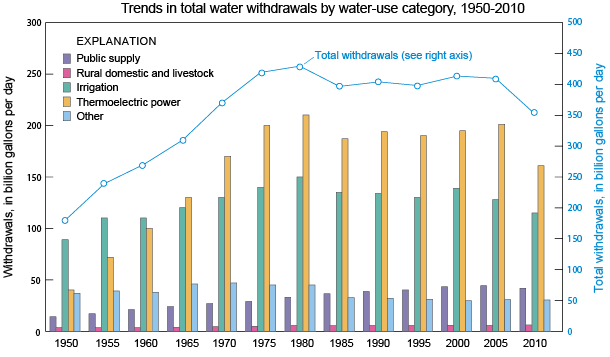I’m not sure what Nebraska attorney David Cookson was up to in this recent talk in Kearney. He seems to be trying to scare the crap out of Nebraskans about water wars risk, of Californians and rich Wall Street money hounds coming after his state’s water. Whatever, this statement, at the heart of his argument, is flat wrong:
“The demand for water never goes down. Ever,” he said.
Here’s the water use trend data, from the U.S. Geologic Survey:
There’s a frustrating linguistic confusion that I need to sort out between “use” and “demand”, which have both technical and plain English meanings that don’t always line up and hide conceptual difficulties. But by whatever word you choose, water use/demand across every sector of the U.S. economy – irrigation, municipal, power plant cooling – has gone down.


We have to advocate for the distinction between consumption and demand. The term “demand” does have a very useful meaning in economics, and because of that meaning we can demonstrate that demand management is almost always a less expensive approach in water management than “new” sources of supply. Imagine if gasoline or electricity were almost free to users, as water is to many western water users. Then the question would only be how much one could use if someone else were paying for it. That’s essentially the basis of the argument for a Gila Diversion project- let’s build it and the taxpayers will foot the costs. Old school state engineers have charts with rising populations and rising “demand” ready to justify any and all water boondoggles.
I agree with Denise. I will add that these figures miss LOCAL S-D imbalances, that they do NOT include the impact(s) of unmeasured use/supply (e.g., g/w and/or precip), and fail to account for “irrigation efficiency” that has reduced return flows. So, no, it’s NOT that clear cut.